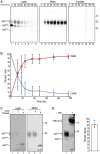Secretion of functional α1-antitrypsin is cell type dependent: Implications for intramuscular delivery for gene therapy
- PMID: 35901208
- PMCID: PMC9351467
- DOI: 10.1073/pnas.2206103119
Secretion of functional α1-antitrypsin is cell type dependent: Implications for intramuscular delivery for gene therapy
Abstract
Heterologous expression of proteins is used widely for the biosynthesis of biologics, many of which are secreted from cells. In addition, gene therapy and messenger RNA (mRNA) vaccines frequently direct the expression of secretory proteins to nonnative host cells. Consequently, it is crucial to understand the maturation and trafficking of proteins in a range of host cells including muscle cells, a popular therapeutic target due to the ease of accessibility by intramuscular injection. Here, we analyzed the production efficiency for α1-antitrypsin (AAT) in Chinese hamster ovary cells, commonly used for biotherapeutic production, and myoblasts (embryonic progenitor cells of muscle cells) and compared it to the production in the major natural cells, liver hepatocytes. AAT is a target protein for gene therapy to address pathologies associated with insufficiencies in native AAT activity or production. AAT secretion and maturation were most efficient in hepatocytes. Myoblasts were the poorest of the cell types tested; however, secretion of active AAT was significantly augmented in myoblasts by treatment with the proteostasis regulator suberoylanilide hydroxamic acid, a histone deacetylase inhibitor. These findings were extended and validated in myotubes (mature muscle cells) where AAT was transduced using an adeno-associated viral capsid transduction method used in gene therapy clinical trials. Overall, our study sheds light on a possible mechanism to enhance the efficacy of gene therapy approaches for AAT and, moreover, may have implications for the production of proteins from mRNA vaccines, which rely on the expression of viral glycoproteins in nonnative host cells upon intramuscular injection.
Keywords: endoplasmic reticulum; protein quality control; proteostasis; proteostasis regulator; serpin.
Conflict of interest statement
Competing interest statement: The authors declare a competing interest. T.R.F. serves on the scientific advisory board of Ferring Ventures, S.A., and was a scientific founder of Applied Genetic Technologies Corporation. The other authors declare no competing or financial interests.
Figures





Similar articles
-
Monitoring the Secretion and Activity of Alpha-1 Antitrypsin in Various Mammalian Cell Types.Methods Mol Biol. 2024;2750:143-163. doi: 10.1007/978-1-0716-3605-3_14. Methods Mol Biol. 2024. PMID: 38108975 Free PMC article.
-
Gene Delivery of Alpha-1-Antitrypsin Using Recombinant Adeno-Associated Virus (rAAV).Methods Mol Biol. 2018;1826:183-196. doi: 10.1007/978-1-4939-8645-3_12. Methods Mol Biol. 2018. PMID: 30194601
-
Survival Advantage of Both Human Hepatocyte Xenografts and Genome-Edited Hepatocytes for Treatment of α-1 Antitrypsin Deficiency.Mol Ther. 2017 Nov 1;25(11):2477-2489. doi: 10.1016/j.ymthe.2017.09.020. Epub 2017 Sep 25. Mol Ther. 2017. PMID: 29032169 Free PMC article.
-
Advances in Alpha-1 Antitrypsin Gene Therapy.Am J Respir Cell Mol Biol. 2020 Nov;63(5):560-570. doi: 10.1165/rcmb.2020-0159PS. Am J Respir Cell Mol Biol. 2020. PMID: 32668173 Free PMC article. Review.
-
Current status of gene therapy for α-1 antitrypsin deficiency.Expert Opin Biol Ther. 2015 Mar;15(3):329-36. doi: 10.1517/14712598.2015.978854. Epub 2014 Nov 3. Expert Opin Biol Ther. 2015. PMID: 25363251 Review.
Cited by
-
From Rat Tails to Glycoproteostasis: Motivated by Biology, Enabled by Biophysics, and Lucky.J Mol Biol. 2025 Jun 1;437(11):169055. doi: 10.1016/j.jmb.2025.169055. Epub 2025 Feb 28. J Mol Biol. 2025. PMID: 40024434 Review.
-
ER chaperones use a protein folding and quality control glyco-code.Mol Cell. 2023 Dec 21;83(24):4524-4537.e5. doi: 10.1016/j.molcel.2023.11.006. Epub 2023 Dec 4. Mol Cell. 2023. PMID: 38052210 Free PMC article.
-
N-glycan-dependent protein maturation and quality control in the ER.Nat Rev Mol Cell Biol. 2025 May 19. doi: 10.1038/s41580-025-00855-y. Online ahead of print. Nat Rev Mol Cell Biol. 2025. PMID: 40389697 Review.
References
-
- Gettins P. G. W., Serpin structure, mechanism, and function. Chem. Rev. 102, 4751–4804 (2002). - PubMed
Publication types
MeSH terms
Substances
Grants and funding
LinkOut - more resources
Full Text Sources
Other Literature Sources
Medical
Research Materials
Miscellaneous

